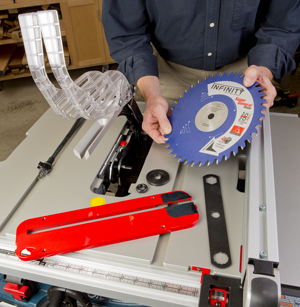
Why do table saws and radial arm saws come in 10-in. blade sizes? Why not larger? Also, I don’t see any 8-in. saws anymore. – Ray Jodoin
Tim Inman: Saws do come in all kinds of sizes, based on the blade diameter. Ten inches seems to be the most common, and it is a practical size. At ten inches, a common “two inch” dimensional lumber piece can be easily sawed all the way through without straining the limits of the saw. Not much more “above the table” cutting depth is ordinarily needed, and you get it easily with a 10-in. blade.
So, other than that, here is an even more practical consideration. The surface feet per minute rating (SFPM) recommended on saws is somewhere around 10,000 feet per minute. Most specify never to turn a saw faster than 18,000 SFPM. This is SFPM, not RPM – simple revolutions per minute. SFPM is the measure of the travel speed of the cutting tooth. At a given RPM, the bigger the blade, the faster the cutting tooth is traveling. A common electric saw motor RPM is about 3,450. So simple math will tell us that a 10-in. blade turning at 3,450 yields a nice surface cutting speed ( the “ground speed” at which the actual cutting teeth are traveling) of just over 9,000. Spot on for “best” category of cutting speeds.
Bigger blades mean faster surface cutting speeds, which means a greater need for power. A 12-in. blade running on the same 3,450 motor would need at least twice the horsepower to do the same job. And unless the blade is adjusted by belting pulleys, that cutting tip is really flying! So a 12-in. blade is usually cutting much “faster” than a 10-in. blade. This means the 12-in. blade is also prone to getting hot faster when it starts to get dull. Smaller saws — like the 8-in. one you mention — can’t cut the depth of a 2 x 4 easily. And, they are, well, just uncommon. So, 10-in. saws seem to have won the day. Mass production and “common” make them very affordable, too.





